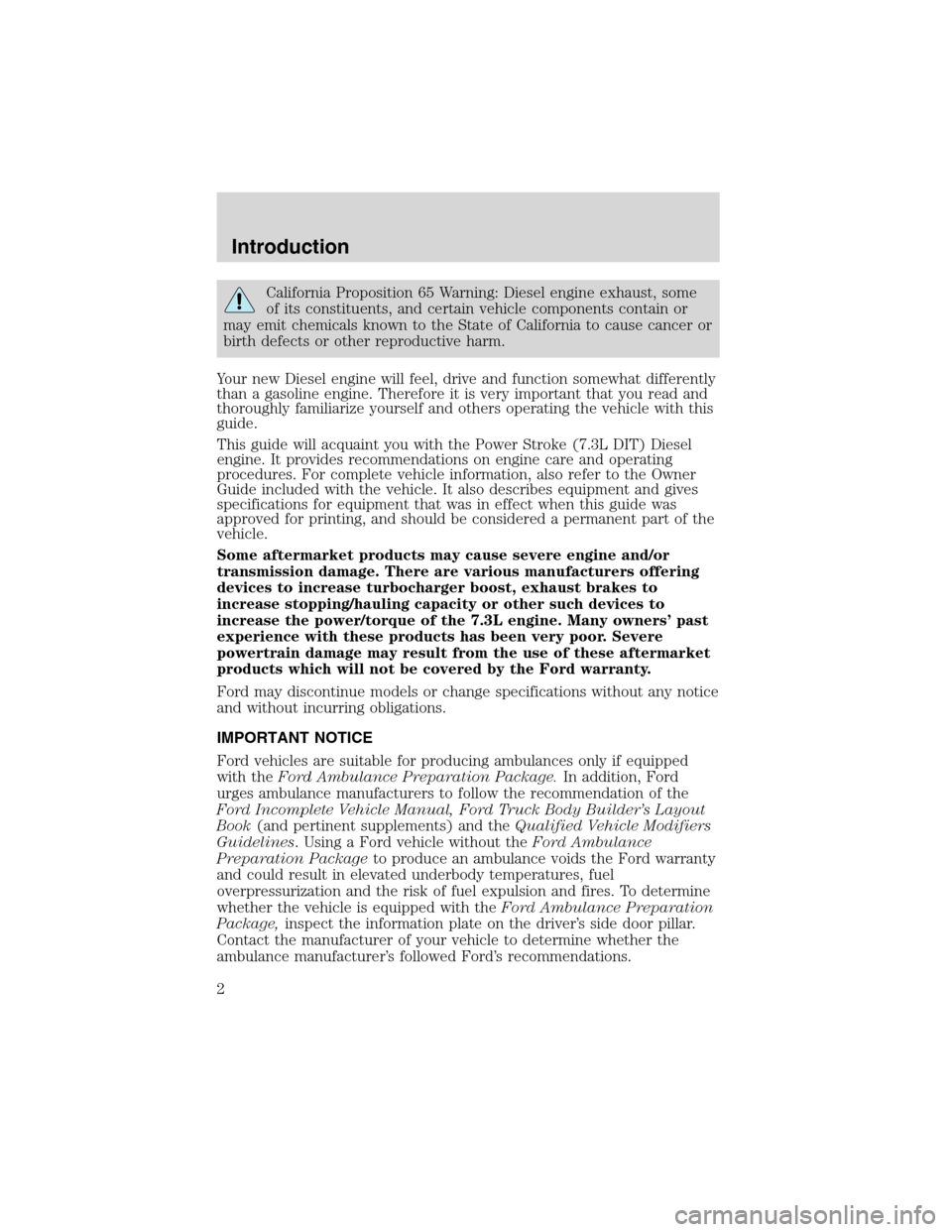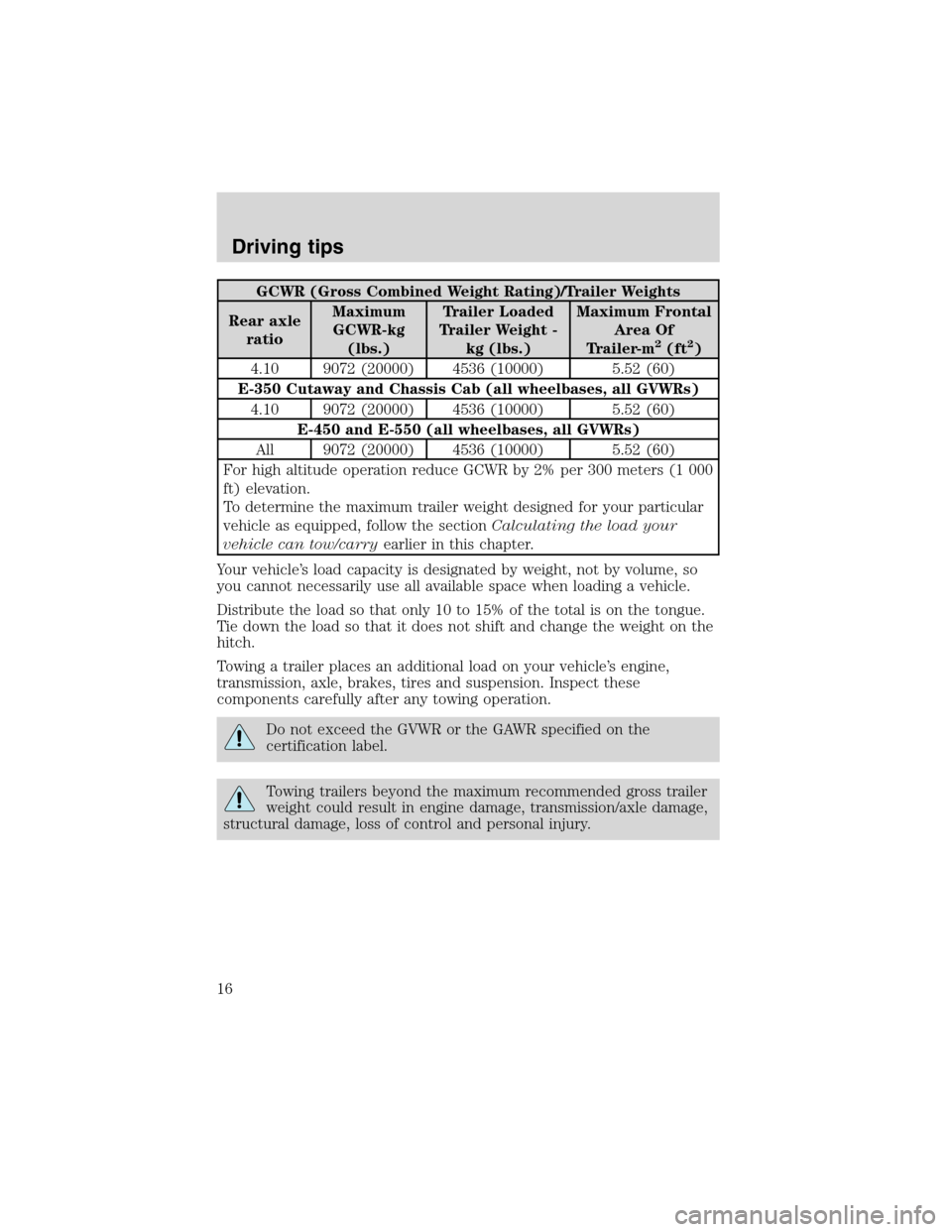Page 2 of 56

California Proposition 65 Warning: Diesel engine exhaust, some
of its constituents, and certain vehicle components contain or
may emit chemicals known to the State of California to cause cancer or
birth defects or other reproductive harm.
Your new Diesel engine will feel, drive and function somewhat differently
than a gasoline engine. Therefore it is very important that you read and
thoroughly familiarize yourself and others operating the vehicle with this
guide.
This guide will acquaint you with the Power Stroke (7.3L DIT) Diesel
engine. It provides recommendations on engine care and operating
procedures. For complete vehicle information, also refer to the Owner
Guide included with the vehicle. It also describes equipment and gives
specifications for equipment that was in effect when this guide was
approved for printing, and should be considered a permanent part of the
vehicle.
Some aftermarket products may cause severe engine and/or
transmission damage. There are various manufacturers offering
devices to increase turbocharger boost, exhaust brakes to
increase stopping/hauling capacity or other such devices to
increase the power/torque of the 7.3L engine. Many owners’ past
experience with these products has been very poor. Severe
powertrain damage may result from the use of these aftermarket
products which will not be covered by the Ford warranty.
Ford may discontinue models or change specifications without any notice
and without incurring obligations.
IMPORTANT NOTICE
Ford vehicles are suitable for producing ambulances only if equipped
with theFord Ambulance Preparation Package.In addition, Ford
urges ambulance manufacturers to follow the recommendation of the
Ford Incomplete Vehicle Manual, Ford Truck Body Builder’s Layout
Book(and pertinent supplements) and theQualified Vehicle Modifiers
Guidelines. Using a Ford vehicle without theFord Ambulance
Preparation Packageto produce an ambulance voids the Ford warranty
and could result in elevated underbody temperatures, fuel
overpressurization and the risk of fuel expulsion and fires. To determine
whether the vehicle is equipped with theFord Ambulance Preparation
Package,inspect the information plate on the driver’s side door pillar.
Contact the manufacturer of your vehicle to determine whether the
ambulance manufacturer’s followed Ford’s recommendations.
Introduction
2
Page 10 of 56

STARTING THE ENGINE
Read all starting instructions carefully before you start your vehicle.
For temperatures below 0°C (32°F), the use of the correct grade engine
oil is essential for proper operation.
If your vehicle is equipped with a manual transmission, make sure the
parking brake is set fully before you turn the key. Depress the clutch
pedal and place the gearshift in the neutral position. The clutch must be
fully depressed in order to operate the starter. Do not press the
accelerator during starting.
If your vehicle is equipped with an automatic transmission, ensure the
gearshift lever is in P (Park) and the parking brake is set before you turn
the key. Do not press the accelerator during starting.
COLD WEATHER STARTING
Do not crank the engine for more than 30 seconds at a time as starter
damage may occur. If the engine fails to start, turn the key to OFF and
wait 30 seconds before trying again.
Do not use starting fluid such as ether in the air intake system (see Air
Cleaner Decal). Such fluid could cause immediate explosive damage to
the engine and possible personal injury.
Do not add gasoline, gasohol or alcohol to Diesel fuel. This practice
creates a serious fire hazard and causes engine performance problems.
1. Make sure all vehicle occupants have buckled their safety belts. For
more information on safety belts and their proper usage, refer toSeating
and safety restraintschapter in the owner guide.
2. Make sure the headlamps and vehicle accessories are off.
3. Turn the key to the ON position. When the WAIT TO START light
goes off, turn the key to START. (For Canadian vehicles, the daytime
running lamps will be on if the parking brake is not applied and the key
is turned to ON.)
•E-Series
•F-250/350/450/550, Excursion
Starting
10
Page 16 of 56

GCWR (Gross Combined Weight Rating)/Trailer Weights
Rear axle
ratioMaximum
GCWR-kg
(lbs.)Trailer Loaded
Trailer Weight -
kg (lbs.)Maximum Frontal
Area Of
Trailer-m
2(ft2)
4.10 9072 (20000) 4536 (10000) 5.52 (60)
E-350 Cutaway and Chassis Cab (all wheelbases, all GVWRs)
4.10 9072 (20000) 4536 (10000) 5.52 (60)
E-450 and E-550 (all wheelbases, all GVWRs)
All 9072 (20000) 4536 (10000) 5.52 (60)
For high altitude operation reduce GCWR by 2% per 300 meters (1 000
ft) elevation.
To determine the maximum trailer weight designed for your particular
vehicle as equipped, follow the sectionCalculating the load your
vehicle can tow/carryearlier in this chapter.
Your vehicle’s load capacity is designated by weight, not by volume, so
you cannot necessarily use all available space when loading a vehicle.
Distribute the load so that only 10 to 15% of the total is on the tongue.
Tie down the load so that it does not shift and change the weight on the
hitch.
Towing a trailer places an additional load on your vehicle’s engine,
transmission, axle, brakes, tires and suspension. Inspect these
components carefully after any towing operation.
Do not exceed the GVWR or the GAWR specified on the
certification label.
Towing trailers beyond the maximum recommended gross trailer
weight could result in engine damage, transmission/axle damage,
structural damage, loss of control and personal injury.
Driving tips
16
Page 50 of 56
E-SERIES ENGINE COMPARTMENT
1. Battery
2. Windshield washer fluid reservoir
3. Engine oil dipstick
4. Fuel filter/water separator drain valve release handle
5. Automatic transmission fluid dipstick
6. Air filter assembly
7. Engine oil filler
8. Air filter restriction gauge
9. Power steering fluid reservoir
10. Brake fluid reservoir
11. Engine coolant recovery reservoir
1
2345678910
11
Service points
50
Page 51 of 56
F-SERIES AND EXCURSION ENGINE COMPARTMENT
1. Battery (dual batteries shown)
2. Engine coolant recovery reservoir
3. Engine oil filler
4. Engine oil dipstick
5. Automatic transmission dipstick (if equipped)
6. Fuel filter drain valve
7. Clutch fluid reservoir (if equipped)
8. Brake fluid reservoir
9. Air filter restriction gauge
10. Air filter assembly
11. Power steering fluid reservoir
12. Windshield washer fluid reservoir
Service points
51